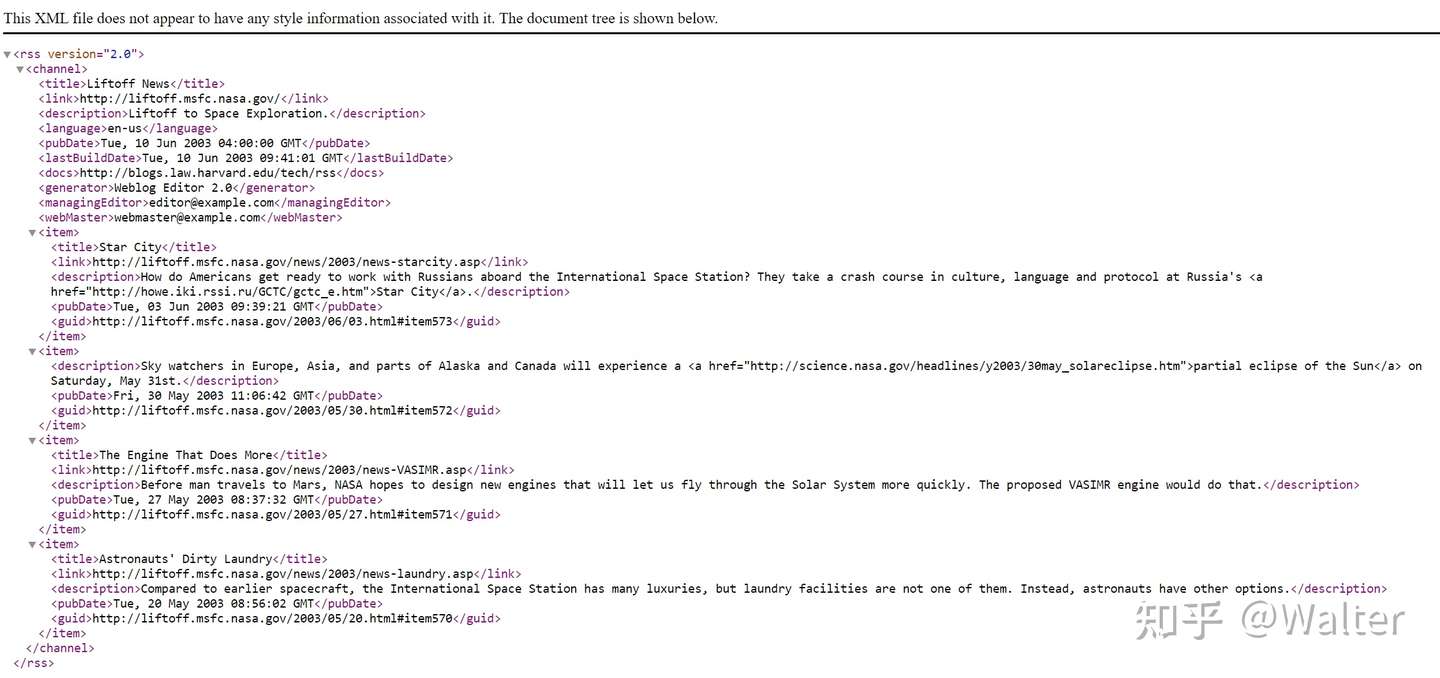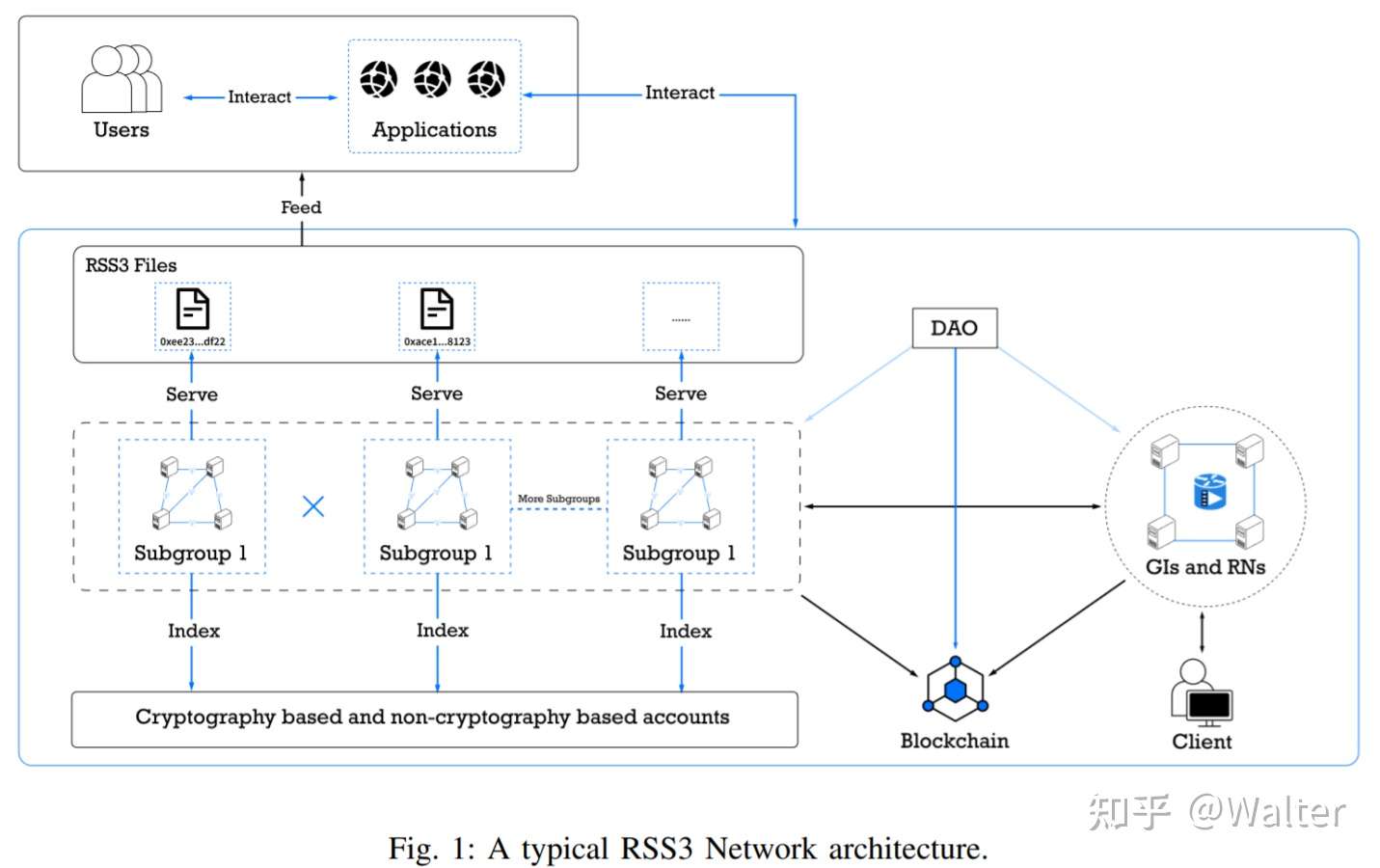Understanding RSS3: Redefining Data Distribution and Ownership in the Web 3.0 Protocol
Author: Walter, Web3 investor Twitter @Walter_JCHuang
- RSS3 is a next-generation data distribution protocol that combines blockchain technology and is derived from the RSS protocol, characterized by flexibility, efficiency, scalability, and decentralization.
- The RSS protocol was developed by early developers to facilitate tracking website updates and capturing content; it is an open-source, simple, and free protocol.
- The application experience of the RSS protocol, which allows information to be obtained without visiting the source site, has severely impacted the traffic acquisition of Web2 internet giants; the characteristic of RSS protocol content not displaying source site advertisements has greatly undermined the advertising revenue of Web2 internet giants. As a result, Web2 internet giants abandoned the RSS protocol and built closed social networking systems based on their own traffic systems and business models.
- The difficulty of reaching consensus among most Web1 underlying decentralized protocols is higher than that of centralized closed products. In the absence of consensus and incentive mechanisms, it is challenging to build ecosystems and products. After the emergence of blockchain technology, a group of underlying decentralized internet protocols, exemplified by RSS, is expected to construct economic models and business models.
- With the frequent emergence of data breaches, privacy security issues, opinion manipulation, algorithm abuse, profit extraction, and data monopolies in the Web2 era, concerns have been increasingly raised. We begin to miss the pure, simple, free, and open underlying protocols of the Web1 internet like the RSS protocol, which represents the "original intention" of the internet. RSS3 was born against this backdrop and vision.
- Decentralized information flow can be roughly divided into four layers: Creation, Storage, Distribution, and Rendering. RSS3 will focus on the decentralized distribution of information and provide corresponding storage solutions and display modules.
- The RSS3 protocol allows users to generate RSS3 files based on their Ethereum addresses and associate their Twitter, Kuaishou, and other social platforms with that file. The file will synchronize the user's assets (digital assets, tweets, etc.) and actions (transactions, likes, retweets, etc.) on other platforms in real-time, storing this information in the RSS3 decentralized network, ultimately ensuring that user data belongs to the user and is not "kidnapped" by centralized platforms.
- Developers of RSS3 ecosystem applications can filter and display different information based on application characteristics with user permission, and can retrieve content published on different platforms through various API interfaces. Ultimately, decentralized applications such as decentralized Instagram, decentralized Twitter, and decentralized WeChat can be built based on RSS3.
- RSS3 has an independent blockchain system, and the network mainly consists of service node groups and global indexers. The service node group is composed of several service nodes, primarily responsible for the daily operation of the RSS3 network; the global indexer is composed of several relay nodes, mainly responsible for the security, governance, and performance management of the RSS3 network.
- The RSS3 ecosystem applications and the RSS3 network will provide us with a free decentralized environment for data creation, storage, and distribution. This fundamentally addresses the issues of data breaches, privacy security, opinion manipulation, algorithm abuse, profit extraction, and data monopolies caused by internet giants in the Web2 era.
- We refer to an internet free from social opinion manipulation, profit extraction, and data monopolies as Web3.0; we call an information society that does not forget the original intention of the internet and conforms to user needs the Web3.0 era. RSS3 is an important piece of the puzzle for achieving Web3.0, an essential foundational tool and protocol that helps us step into the Web3.0 era.
1. The RSS Protocol: From Prosperity to Decline
To discuss RSS3, we must start with the RSS protocol.
In the Web1 era, information was primarily generated and disseminated through portal websites, and users obtained information by visiting these sites. To facilitate users in tracking website updates and capturing content, early developers established the open-source, simple, and free RSS protocol. RSS stands for "Really Simple Syndication," which provides a distribution service for website content, typically sent to email. Users no longer need to log in to websites to check; they can receive timely updates on website information.
When RSS detects new information on a website, it immediately records the title, author, content, and data source in an RSS file using a specific language (XML markup language), triggering content distribution. Thus, email users receive new information notifications simultaneously. To date, the RSS protocol has evolved to version 2.0 and is still used by various websites; it is the subscription feature we are familiar with.
 (Example of an RSS file, image source: Berkman Klein Center, Harvard University)
(Example of an RSS file, image source: Berkman Klein Center, Harvard University)
Because it met user needs, the RSS protocol was once highly sought after and widely used, with numerous RSS-based readers available. However, in the centralized internet-controlled Web2 era, the ability of RSS to obtain information without visiting the source site, combined with its high data timeliness and reading efficiency, severely impacted the traffic acquisition of Web2 internet giants.
Moreover, the characteristic of RSS content not displaying source site advertisements greatly aligned with user preferences while significantly undermining the advertising revenue of Web2 giants. As the internet gradually became more centralized and commercialized, internet giants established closed internal content distribution and relationship networks, conducting business activities based on this, which they referred to as Social Graph. This includes the information dissemination tools we use, such as WeChat, Facebook, and Twitter.
Furthermore, the difficulty of reaching consensus on decentralized open protocols is higher than that of centralized closed products. Additionally, before the widespread application of blockchain technology, there were no effective incentive mechanisms to help decentralized protocols build ecosystems and products. Thus, the RSS protocol has become marginalized in the Web2 era controlled by internet giants.
However, with the frequent emergence of data breaches, privacy security issues, opinion manipulation, algorithm abuse, profit extraction, and data monopolies in the Web2 era, concerns have been increasingly raised. We begin to miss the pure, simple, free, and open underlying protocols of the Web1 internet like the RSS protocol, which represents the "original intention" of the internet. Against this backdrop and vision, RSS3 quietly emerged.
2. RSS3: A Lightning Return
RSS3 integrates blockchain technology and the RSS protocol, aiming to build a flexible, efficient, and scalable decentralized information distribution protocol.
Like most Web1 underlying protocols, the RSS protocol lacks incentive mechanisms, making it difficult to construct business models or economic ecosystems. The emergence of blockchain and digital currencies perfectly addresses the incentive issues of Web1 underlying protocols, allowing these protocols to incentivize contributors to the underlying decentralized network, reward ecosystem developers, and ultimately bind the interests of multiple parties, including the network, products, users, developers, network maintainers, and resource contributors, to work together cooperatively.
Decentralized data flow can be roughly divided into four layers: Creation, Storage, Distribution, and Rendering. RSS3 primarily focuses on the decentralized distribution of data and provides corresponding storage solutions and display modules.
When users use applications in the RSS3 ecosystem (we can try it at https://rss3.co/), the application will help users establish an RSS3 file in the RSS3 decentralized network. This file is set up with an Ethereum address, and users can add multiple public keys from decentralized networks or accounts from centralized systems into the RSS3 file, establishing friendships in RSS3 and creating their own content push aggregation entry and social graph.
As shown in the figure below, in my RSS3 file, I can see that I have added my Ethereum address, Twitter, and Kuaishou into my RSS3 folder. My friends in the RSS3 ecosystem will receive timely notifications of my relevant content when using RSS3 ecosystem applications.
 Image source: RSS3 File
Image source: RSS3 File
For application developers, they can filter and display different information based on application characteristics and retrieve content published on different platforms through various API interfaces. Developers can build decentralized applications such as decentralized Instagram, decentralized Twitter, and decentralized WeChat based on RSS3.
3. RSS3 Network Architecture and Vision
RSS3 will build a blockchain network and operate in the form of a DAO. The network mainly consists of service nodes and relay nodes, where:
- Service nodes: Several service nodes will randomly form a service node group, primarily responsible for storing, managing, and synchronizing users' RSS3 files and handling content push within the network. This serves as the basic working unit of the RSS3 network.
- Relay nodes: Several relay nodes, along with the storage archiving modules in the network, form the global indexer, primarily responsible for managing service node groups, routing data requests for RSS3 ecosystem applications, and maintaining network performance. This serves as the governance and performance management unit of the RSS3 network.
 Image source: RSS3 White Paper
Image source: RSS3 White Paper
The global indexer and service node groups will be elected by the network. Matters such as the election of the global indexer and service node groups, the upper limit of the number of network nodes, penalties for node misconduct, node incentive mechanisms, network module upgrades, and treasury management will all be decided by votes from RSS3 token holders. For more design and technical details, please refer to the RSS3 white paper: https://rss3.io/#/whitepaper
In the RSS3 ecosystem, users' content pushes and RSS3 files will be saved and managed by dynamically random service node groups, eliminating reliance on a single node. When the RSS3 network is sufficiently decentralized, users' data will ultimately belong to the users, and they will not have to worry about losing content and social graphs due to bans from centralized social software like Twitter and Kuaishou. Applications built on the RSS3 ecosystem cannot control users' data, allowing users to smoothly and frictionlessly transition from decentralized Twitter to decentralized Facebook without losing social data and relationships, thus avoiding being "kidnapped" by social platforms.
Ultimately, the RSS3 ecosystem applications and the RSS3 network will provide us with a free decentralized environment for data creation, storage, and distribution. This fundamentally addresses the issues of data breaches, privacy security, opinion manipulation, algorithm abuse, profit extraction, and data monopolies caused by internet giants in the Web2 era.
We refer to this ideal as Web3.0, a product that returns data ownership to users; an internet free from social opinion manipulation, profit extraction, and data monopolies; an information society that does not forget the original intention of the internet and conforms to user needs. RSS3 is an important piece of the puzzle for achieving this ideal, an essential foundational tool and protocol that helps us step into the Web3.0 era.









